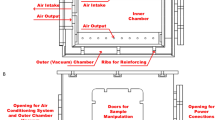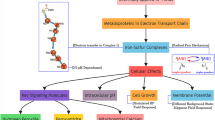Abstract
The effect of pulsed electromagnetic fields (PEMF) similar to those used in transcranial magnetic stimulation (TMS) on two tumour cell lines, the human promyelocytic leukaemia cell line (HL-60) and the rat pheochromocytoma cell line (PC12), was investigated. The two cell lines were exposed to non-homogeneous pulsed electromagnetic fields (about 0.25–4.5 T peak magnetic field strength; 1–8 exponential pulses, 0.25 Hz) at different positions on the coil (2×25 mm). After exposure with various intensities, various numbers of pulses and at different coil positions, cell viability and the intracellular cyclic AMP content were determined in the two cell lines. Additionally, in HL-60 cells the intracellular Hsp72 content and in PC12 cells the release of the neurotransmitters dopamine, noradrenaline and acetylcholine were measured after PEMF treatment. The results of these analyses do not hint at alterations in the cell viability or in the content of cAMP, Hsp72, dopamine, noradrenaline, and acetylcholine in the two tumour cell lines after PEMF exposure under various conditions.



Similar content being viewed by others
References
D’Arsonval A (1896) Dispositifs pour la mesure des courants alternatifs de toutes frequences. CR Soc Biol (Paris) 450:1–7
Bickford RG, Fremming BD (1965) Neural stimulation by pulsed magnetic fields in animals and man. In: Digest of the 6th international conference on medical electronics and biological engineering, Tokyo, pp 7–6
Barker AT, Jalinous R, Freestone IL (1985) Non-invasive stimulation of the human motor cortex. Lancet 1:1106–1107
Rossini PM, Rossi S (1996) Clinical applications of motor evoked potentials. Electroencephalogr Clin Neurophysiol 106:180–194
Hallett M (2000) Transcranial magnetic stimulation and the human brain. Nature 406:147–150
Cohen LG, Ziemann U, Chen R, Classen J, Hallett M, Gerloff C, Butefisch C (1998) Studies of neuroplasticity with transcranial magnetic stimulation. J Clin Neurophysiol 15:305–324
Grafman J (2000) TMS as a primary brain mapping tool. In: George MS, Belmaker RH (eds) Transcranial magnetic stimulation in neuropsychiatry, Chapter 5. American Psychiatric Press, Washington DC, London, England
George MS, Nahas Z, Bohning DE, Shastri A, Teneback C, Roberts DR, Speer AM, Lorberbaum JP, Vincent DJ, Owens SD, Kozel A, Molloy M, Risch SC (2000) TMS and neuroimaging. In: George MS, Belmaker RH (eds) Transcranial magnetic stimulation in neuropsychiatry, Chapter 14. American Psychiatric Press, Washington DC, London, England
Bohning DE (2000) Introduction and overview of TMS physics. In: George MS, Belmaker RH (eds) Transcranial magnetic stimulation in neuropsychiatry, Chapter 2. American Psychiatric Press, Washington DC, London, England
Sontag W, Dertinger H (1998) Response of cytosolic calcium, cyclic AMP, and cyclic GMP in dimethylsulfoxide-differentiated HL-60 cells to modulated low frequency electric currents. Bioelectromagnetics 19:452–458
Sontag W (2004) Response of cyclic AMP by DMSO-differentiated HL-60 cells exposed to electric interferential current after prestimulation. Bioelectromagnetics 25:176–184
Kowalski T, Silny J, Buchner H (2002) Current density threshold for the stimulation of neurons in the motor cortex area. Bioelectromagnetics 23:421–428
Lorberbaum JP, Wassermann EM (2000) Safety concerns of TMS. In: George MS, Belmaker RH (eds) Transcranial magnetic stimulation in neuropsychiatry, Chapter 6. American Psychiatric Press, Washington DC, London, England
Tenforde TS (1993) Cellular and molecular pathways of extremely low frequency electromagnetic field interactions with living systems. In: Blank M (ed) Electricity and magnetism in biology and medicine. San Fransisco Press, San Francisco, pp 1–8
Luben RA (1994) Membrane signal transduction as a site of electromagnetic field actions in bone and other tissues. In: Frey AH (ed) On the nature of electromagnetic field interactions with biological systems. RG Landes Company, Austin, pp 83–98
Goodman EM, Greenebaum B, Marron MT (1995) Effects of electromagnetic fields on molecules and cells. Int Rev Cytol 158:279–338
Schimmelpfeng J, Dertinger H (1993) The action of 50 Hz magnetic and electric fields upon cell proliferation and cyclic AMP content of cultured mammalian cells. Bioelectrochem Bioenerg 30:143–150
Knedlitschek G, Noszvai-Nagy M, Meyer-Waarden H, Schimmelpfeng J, Weibezahn KF, Dertinger H (1994) Cyclic AMP response in cells exposed to electric fields of different frequencies and intensities. Radiat Environ Biophys 33:141–147
Sontag W (1997) Two experimental systems for exposure of cells to extremely low frequency electric fields suitable for in situ measurements of fluorescence signals. Bioelectrochem Bioenerg 44:141–149
Sontag W (1998) Treatment of zymosan-activated HL-60 cells with low frequencies electric fields does not change cellular ATP and ADP levels and reactive oxygen species. Bioelectrochem Bioenerg 46:255–261
Sontag W (2000) Modulation of cytokine production by interferential current in differentiated HL-60 cells. Bioelectromagnetics 21:238–244
Sontag W (2001) Release of mediators by DMSO-differentiated HL-60 cells exposed to electric interferential current and the requirement of biochemical pre-stimulation. Int J Radiat Biol 77:723–734
Singh-Jasuja H, Hilf N, Arnold-Schild D, Schild H (2001) The role of heat shock proteins and their receptors in the activation of the immune system. Biol Chem 382:629–636
Garrido C, Gurbuxani S, Ravagnan L, Kroemer G (2001) Heat shock proteins: endogenous modulators of apoptotic cell death. Biochem Biophys Res Comm 286:433–442
Goodman R, Blank M, Lin H, Dai R, Khorkova O, Soo L, Weisbrot D, Henderson A (1994) Increased levels of Hsp70 transcripts induced when cells are exposed to low frequency electromagnetic fields. Bioelectrochem Bioenerg 33: 115–120
Lin H, Opler M, Head M, Blank M, Goodman R (1997) Electromagnetic field exposure induces rapid, transitory heat shock factor activation in human cells. J Cell Biochem 66:482–488
Goodman R, Blank M (1998) Magnetic field stress induces expression of hsp70 [review]. Cell Stress Chap 3:79–88
Han L, Lin H, Head M, Blank M, Goodman R (1998) Application of magnetic field-induced hsp70 for pre-surgical cytoprotection. J Cell Biochem 71:577–583
Lin H, Blank M, Rossol-Haseroth K, Goodman R (2001) Regulating genes with electromagnetic response elements. J Cell Biochem 81:143–148
Kang KI, Bouhouche I, Fortin D, Baulieu EE, Catelli MG (1998) Luciferase activity and synthesis of Hsp70 and Hsp90 are insensitive to 50 Hz electromagnetic fields. Life Sci 63:489–497
Tsurita G, Ueno S, Tsuno NH, Nagawa H, Muto T (1999) Effects of exposure to repetitive pulsed magnetic stimulation on cell proliferation and expression of heat shock protein 70 in normal and malignant cells. Biochem Biophys Res Comm 261:689–694
Morehouse CA, Owen RD (2000) Exposure to low-frequency electromagnetic fields does not alter HSP70 expression or HSF–HSE binding in HL60 cells. Rad Res 153:658–662
Henderson BR, Pfister G, Boeck G, Kind M, Wick G (2003) Expression levels of heat shock protein 60 in human endothelial cells in vitro are unaffected by exposure to 50 Hz magnetic fields. Cell Stress Chap 8:172–182
Shi B, Farboud B, Nuccitelli R, Isseroff RR (2003) Power-line frequency electromagnetic fields do not induce changes in phosphorylation, localization, or expression of the 27-kilodalton heat shock protein in human keratinocytes. Environ Health Perspec 111:281–287
Prohaszka Z, Füst G (1982) Immunological aspects of heat-shock proteins—the optimum stress of life. Mol Immunol 41:29–44
Dixey R (1982) 3H-noradrenaline release potentiated in a clonal nerve cell line by low-intensity pulsed magnetic fields. Nature 296:253–256
Opler M, Rukenstein A, Coté L, Goodman R (1997) Reduced dopamine levels in PC12 cells exposed to low frequency electromagnetic fields. Bioelectrochem Bioenerg 42:235–239
Nakatsuka S, Hayashi M, Muroyama A, Otsuka M, Kozaki S, Yamada H, Moriyama Y (2001) A-Aspartate is stored in secretory granules and released through a Ca2+-dependent pathway in a subset of rat pheochromocytoma PC12 cells. J Biol Chem 276:26589–26596
Acknowledgments
We thank Ms Gisela Kampmann and Mechthild Herschbach for their patient and skilful technical assistance. Furthermore, we thank Dr. K.F. Weibezahn for critically reviewing the manuscript.
Author information
Authors and Affiliations
Corresponding author
Rights and permissions
About this article
Cite this article
Sontag, W., Kalka, D. No effect of pulsed electromagnetic fields on PC12 and HL-60 cells. Radiat Environ Biophys 45, 63–71 (2006). https://doi.org/10.1007/s00411-006-0043-6
Received:
Accepted:
Published:
Issue Date:
DOI: https://doi.org/10.1007/s00411-006-0043-6




